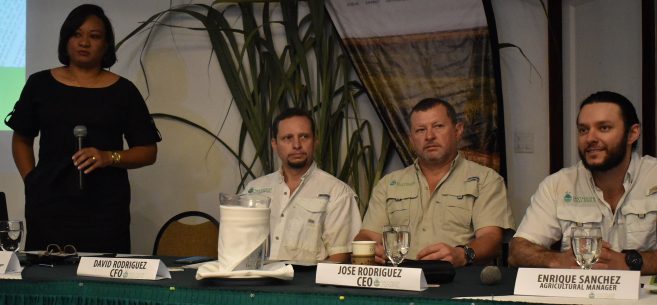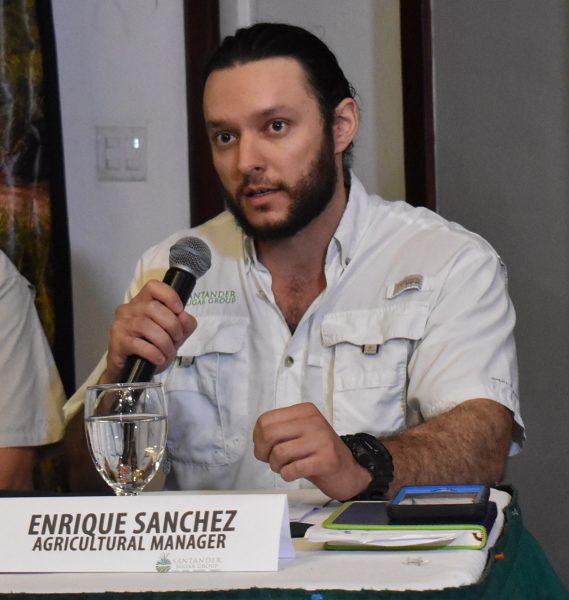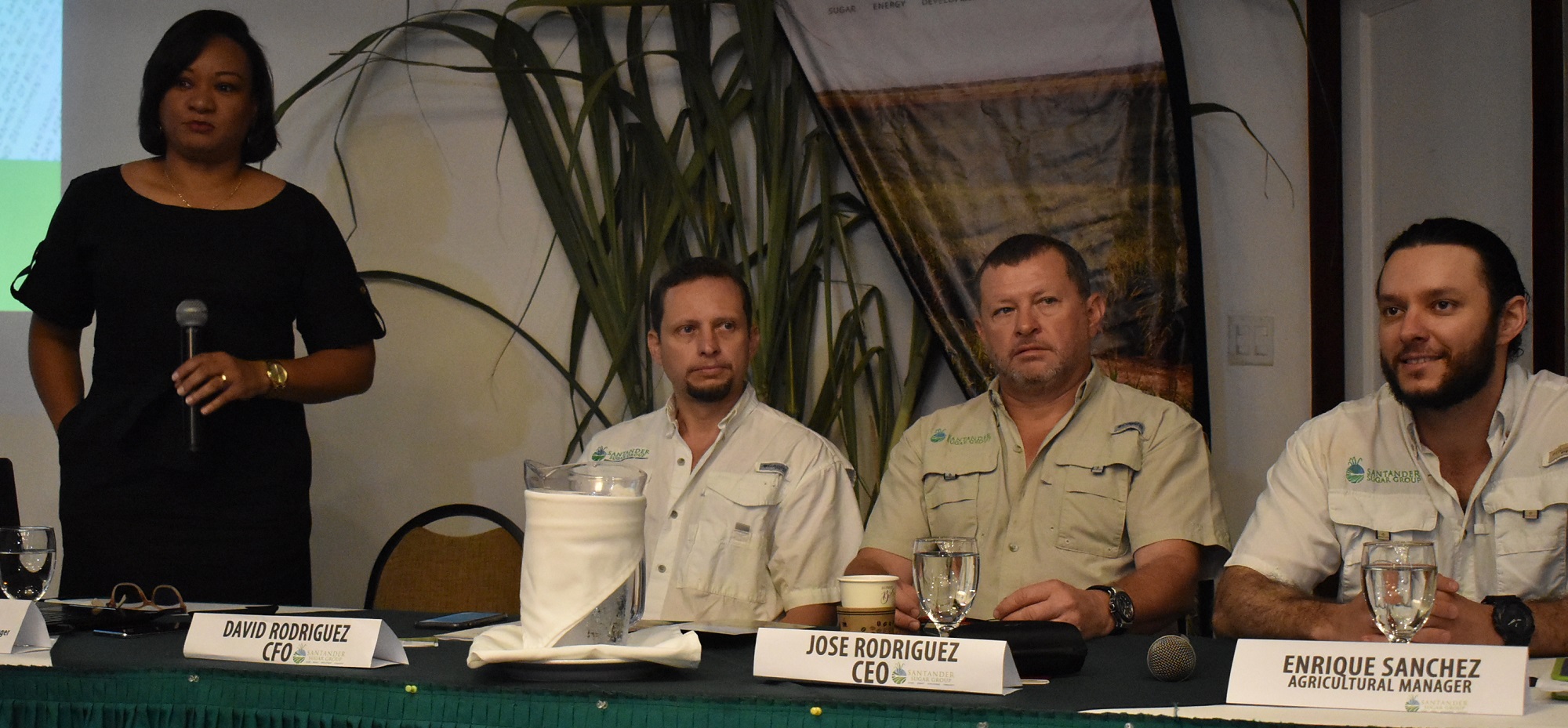Cayo farmers have been offered a sweet deal from the Santander Group, to get into the lucrative sugar industry without any initial investment by the farmers. Santander’s Chief Executive Officer (CEO) Jose Rodriguez says they can enjoy a secure income growing sugarcane while also increasing Belize’s exports and helping the country become self-sufficient in green, clean energy production.
The Santander management team, CEO Jose Rodriguez, his brother, and Chief Financial Officer (CFO) David Rodriguez, Agricultural Manager Enrique Sanchez, and Public Relations Manager Beverly Burke made their pitch to the farmers at a press conference at the Best Western Biltmore Plaza Hotel on Tuesday, February 25th.
No start-up capital? No problem, says CEO Jose Rodriguez, emphasizing that all the farmers need, is to have their lands cleared and prepared for farming. The company’s engineers will do the rest. The company will send in its heavy equipment, guided by high tech, state-of-the-art laser systems, to level the land for correct drainage. The company will do all the heavy lifting at the start, as their machinery will also do the planting and harvesting.
No need for the prospective cane farmer to hire cane cutters or to buy cane seed. The company will completely finance the initial cost of getting the farmer established as a sugar cane grower. The company would collect on the back end to recoup their investment when the farmer brings in his first harvest, with the company’s help.
When it comes to harvest time, the farmers will no longer need to hire cane cutters or a truck to deliver the cane to the factory. The company is 100% mechanized in its field operations, and it will send in its harvester combine to cut the cane and load it on to trucks, which will deliver the cane to the mill. This improves efficiency, reduces sugar losses from deterioration, as there is no long waiting in cane truck lines as was the norm in the north. Almost immediate delivery to the factory cuts the “kill-to-mill” time to a couple of hours.
CEO Rodriguez explained that since sugar cane is ratooned (a method of propagation in which subterranean buds on the part of cane left underground after harvesting give rise to a new crop stand), the farmer would be rolling in the money, as he could continue to harvest cane for the next five-six years, without replanting and the farmer would enjoy the profits once he has repaid Santander’s initial planting cost.
Construction of the Santander sugar mill began near Valley of Peace, Cayo district, in 2014, and the factory was commissioned in February 2016, with the first harvest of “zaffra” beginning in March 2016. The physical plant is about the same size as the ASR/BSI’s sugar factory at Tower Hill, Orange Walk. The plant was originally projected to mill 800,000 tonnes of cane per year, but cane production has not yet met this target.
Santander is encouraging Cayo farmers to get in on this sweet deal, as the factory ground 477,000 tonnes of cane in 2019, producing 44,000 tonnes of sugar, and they plan to produce 57,248 tonnes of sugar from 600,989 tonnes of cane ground this year. The yield or Tonnes Cane to make a Tonne of Sugar (TCTS) of 10.84 last year and 10.49 expected this year is not so good as ASR/BSI’s TCTS of 9.145 in 2019. Some of that cane from Corozal is so sweet; the TCTS cane is as low as 8.0.
Santander’s mechanized, computer-controlled methods of planting, cultivation, irrigation and fertilizing have been achieving far better yields per acre of sugar cane than in Orange Walk and Corozal. They produced 71 metric tonnes of cane per hectare in 2019 – or 28.73 tonnes per acre. This year they expect to produce 70 tonnes cane per hectare or 28.3 tonnes per acre. The Corozal and Orange Walk farmers’ traditional production of 16 – 17 tonnes per acre pales in comparison.
Santander’s CFO Rodriguez explained that the company began producing primarily sugar cane when their father Jose Rodriguez Sr. first emigrated from the town of Santander in Spain, and they only became involved in the integrated production of sugar when they built this new factory in Belize. He further clarified that while his father’s hometown is their namesake, they are not affiliated with the international financial group Santander.
The company grows most of the cane milled, grown on land owned by the company. CEO Rodriguez says they presently have 22,000 acres of sugar cane under cultivation, and they hope to expand with the help of many independent small farmers. He did not quote an exact cane price that would be paid to farmers, but he said Santander would be buying the cane standing in the field. The farmer would have no harvesting nor transportation costs since the company would take responsibility for harvesting and delivery to the mill. This cost can be over $20 or more per tonne, for farmers in the north.
CFO David Rodriguez said Santander is a leader in the region, as the only company which is 100% mechanized in harvesting and cultivation. This technology allows their employees to enjoy better working conditions, by operating state-of-the-art, computer-controlled equipment. The company’s harvesters even have air-conditioned cabs.
The company’s workforce is 750, of which 181 are foreigners, who have transferred this technology to the Belizean workers, who have learned new job skills. Santander’s high-tech operation, by its very nature, needs a highly skilled, well-educated workforce.
Enrique Sanchez, Santander’s agricultural operations manager, explained that the company sends in its heavy machinery to prepare the land for planting, to ensure the spacing of the rows and furrows is optimum for the maximum sugar cane yield. He happily noted that their cane fields were mostly largely unaffected by last year’s drought. This is because Cayo’s fine clay soils retain more water, and the water table of the Santander lands is higher. This had created problems with too much water during flood season, but in the drought, the land retained enough moisture for the cane plants to prosper, without any significant losses. In areas that did require water, the prior preparation of the layout of the fields allowed Santander to use computer-controlled irrigation systems, to apply just the right amount of water needed by the cane, for optimum growth and water savings.
He further explained that the higher water content was part of the reason for the lower sugar yield per tonne cane, and the higher TCTS than in the north, as the Corozal cane had a longer ripening period due to the long dry season. He said Santander is cultivating the same varieties of sugar cane as have been traditionally grown in northern Belize, although they will be experimenting to find new varieties that are more resilient to drought.
CEO Rodriguez said Santander is committed to the future prosperity of Belize, as it has invested heavily in this transfer of the very latest technology. So far, they have invested $500 million in the purchase of land, the construction of the factory, planting and harvesting, and they are also working with the owners of the Big Creek deep-water port, where they ship their product to market. The company has built a storage facility for 15,000 tonnes of bulk sugar at the port and a storage tank for molasses. At Big Creek, the ship berths have been dredged from 6.5 meters down to a new depth of 11 meters, permitting the port to accommodate much larger ships than the Port of Belize. This allows Santander to ship a larger tonnage in one go, than ASR/BSI can do in the smaller ships which dock at Port of Belize, for pretty much the same freight cost. This leads to a substantial savings through economies of scale, reducing the freight cost per tonne to one-sixth what it would cost at Belize City.
This is so attractive, that Santander has entered talks with ASR/BSI to consolidate the industry’s exportation of sugar at a lower cost, and Santander has plans to expand the sugar warehouse from 15,000 tonnes to 60,000 tonnes. It has also been proposed for BSI to experiment with trucking their sugar over land, at a greater cost than their traditional transportation by barge on the New River, to take advantage of the freight savings at Big Creek for shipping to Europe. The stevedores’ union in Belize City has not welcomed this proposal, as they have traditionally earned a good income from loading and unloading BSI’s sugar barges onto the ships in Port of Belize
CEO Jose Rodriguez said they began exporting most of their production to the European Union, but 2017 liberalization of the global sugar trade forced them to adapt when the World Trade Organization eliminated the EU’s preferential sugar quotas for African, Caribbean, and Pacific (ACP) countries. He applauded the Ministry of Trade’s lobbying with CARICOM for Belizean sugar producers to finally penetrate the CARICOM Single Market Economy last year when Santander was able to sell 25% of its production to CSME. Santander had also begun exporting to Taiwan, under newly established quota for Belizean sugar.
He said the company produces and sells several products: raw sugar shipped in bulk, direct consumption plantation white sugar and brown sugar which is shipped in bags, co-generation electricity sold to Belize Electricity Limited’s national grid, and molasses, which CEO Rodriguez says can be used for animal feed and to produce ethanol. Santander signed its power purchase agreement with BEL after the close of their first harvest in December 2016.
There was talk that Belize would begin producing ethanol from molasses when Petrojam bought the old Libertand Sugar Factory on Corozal in the 1980s, but those plans never materialized. More recently, in 2005, under the Central American Integration System (SICA) Belize had signed a technical cooperation agreement with Brazil for the transfer of technology in gasohol production, a technology that Brazil has mastered and perfected from the 1970s.
Prime Minister Hon. Dean Barrow had also referred to a new venture, “Blue Sky,” shortly after he was elected in April 2008. He said Blue Sky would produce ethanol to improve the octane rating of Belize Natural Energy’s crude petroleum, as a motor fuel offering significant savings at the pump for Belizean motorists. To date, no such plan has materialized.

Share
Read more

